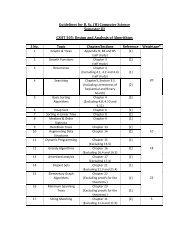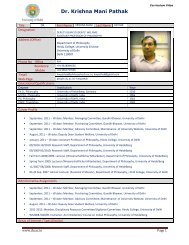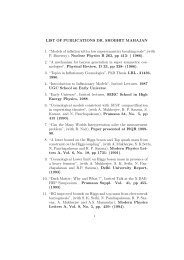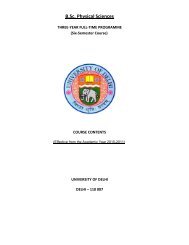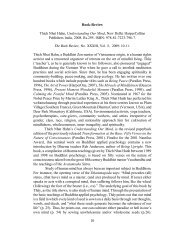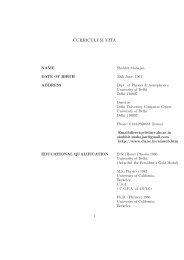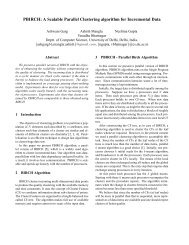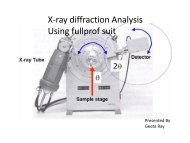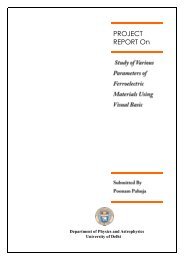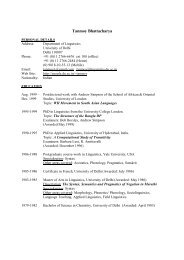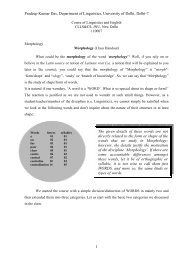Clay illuviation in calcareous soils of the semiarid - Home Pages of ...
Clay illuviation in calcareous soils of the semiarid - Home Pages of ...
Clay illuviation in calcareous soils of the semiarid - Home Pages of ...
Create successful ePaper yourself
Turn your PDF publications into a flip-book with our unique Google optimized e-Paper software.
188<br />
3.3. Depth distribution <strong>of</strong> clay m<strong>in</strong>erals, CEC, exchangeable sodium and ESP<br />
The presence <strong>of</strong> field-identifiable clay sk<strong>in</strong>s and impure clay ped<strong>of</strong>eatures confirm <strong>the</strong><br />
<strong>illuviation</strong> <strong>of</strong> clay. As a result, clay <strong>in</strong>creases considerably with depth. The ratio <strong>of</strong> clay<br />
content <strong>of</strong> <strong>the</strong> Bt horizon to that <strong>of</strong> <strong>the</strong> A horizon is >1.2. Like clay, <strong>the</strong> CEC and ES<br />
values <strong>in</strong>crease with depth down to <strong>the</strong> Bt horizons and <strong>the</strong>n decrease <strong>in</strong> both Haplustalf<br />
and Natrustalf (Table 2).<br />
The <strong>illuviation</strong> <strong>of</strong> clay has also resulted <strong>in</strong> a typical depth distribution <strong>of</strong> mica and<br />
vermiculite plus smectite <strong>in</strong> <strong>the</strong> whole clay fraction <strong>of</strong> <strong>the</strong> <strong>soils</strong> (Fig. 5). This has been<br />
expla<strong>in</strong>ed by preferential movement <strong>of</strong> vermiculite and smectite along with f<strong>in</strong>e clay<br />
fractions <strong>in</strong>to <strong>the</strong> B horizons result<strong>in</strong>g <strong>in</strong> an <strong>in</strong>crease <strong>in</strong> <strong>the</strong> proportion <strong>of</strong> mica <strong>in</strong> <strong>the</strong> A<br />
horizon, and that <strong>of</strong> vermiculite and smectite <strong>in</strong> <strong>the</strong> B horizons (Pal and Bhargava, 1985;<br />
Pal et al., 1994). This suggests that movement <strong>of</strong> <strong>the</strong> f<strong>in</strong>er clay particles <strong>in</strong> a deflocculated<br />
form can enrich B horizons with clay. Due to loss <strong>of</strong> clay <strong>in</strong> <strong>the</strong> A horizons and ga<strong>in</strong> <strong>the</strong><br />
Na-clay <strong>in</strong> <strong>the</strong> B horizons, both ES and CEC show an <strong>in</strong>crease with depth <strong>in</strong> both<br />
Haplustalfs and Naturstalfs. However, due to low amount <strong>of</strong> soluble bicarbonate and<br />
carbonate <strong>of</strong> sodium (Table 3), Haplustalfs show an <strong>in</strong>crease <strong>in</strong> ESP with depth. By<br />
contrast, Natrustalfs show decreas<strong>in</strong>g trend <strong>in</strong> ESP with depth amidst very high amount <strong>of</strong><br />
soluble sodium bicarbonate and carbonate (Table 3) and low amount <strong>of</strong> clay and CEC <strong>in</strong><br />
<strong>the</strong> upper horizons (Table 2).<br />
4. Discussion<br />
D.K. Pal et al. / Geoderma 115 (2003) 177–192<br />
The results <strong>of</strong> <strong>the</strong> study clearly <strong>in</strong>dicate <strong>the</strong> <strong>illuviation</strong> <strong>of</strong> clay particles <strong>in</strong> <strong>calcareous</strong><br />
<strong>soils</strong> with loamy-textured parent material under <strong>the</strong> ustic soil moisture regime. However,<br />
<strong>illuviation</strong> <strong>of</strong> clay has resulted only <strong>in</strong> ‘‘impure clay ped<strong>of</strong>eatures’’ because <strong>the</strong> parallel<br />
orientation <strong>of</strong> <strong>the</strong> clay platelets has been impaired by deflocculation <strong>of</strong> <strong>the</strong> clay colloids<br />
(Pal et al., 1994). This suggests that <strong>the</strong> removal <strong>of</strong> CaCO3 is less important for <strong>the</strong><br />
movement <strong>of</strong> clay as suggested earlier (Jenny, 1941; Smith et al., 1950; Bartelli and Odell,<br />
1960; Culver and Gray, 1968; Dankert and Drew, 1970; Gile and Hawley, 1972). It was<br />
thought earlier that calcium ion enhances flocculation and immobilization <strong>of</strong> colloidal<br />
material (Bartelli and Odell, 1960). However, <strong>the</strong> pH <strong>of</strong> a system conta<strong>in</strong><strong>in</strong>g CaCO 3 <strong>in</strong><br />
water <strong>in</strong> equilibrium with <strong>the</strong> atmosphere is 8.4 and <strong>the</strong> ionic strength is so low that<br />
correction for <strong>the</strong> difference <strong>of</strong> molality and activity is hardly worthwhile (Garrels and<br />
Christ, 1965). Marshall (1964) <strong>in</strong>dicates that CaCO3 ma<strong>in</strong>ta<strong>in</strong>s a concentration <strong>of</strong> Ca 2+<br />
ions <strong>in</strong> a solution <strong>of</strong> 0.25–5.00 meq/l, depend<strong>in</strong>g on <strong>the</strong> partial pressure <strong>of</strong> CO2 <strong>in</strong> contact<br />
with it. Rimmer and Greenland (1976) also po<strong>in</strong>ted out that at a calcium concentration <strong>of</strong> 5<br />
meq/l, <strong>the</strong> swell<strong>in</strong>g <strong>of</strong> Ca-montmorillonite is only 15% less than that <strong>in</strong> distilled water. The<br />
saturation extract <strong>of</strong> Haplustalfs and Natrustalfs under study <strong>in</strong>dicates a very low amount<br />
<strong>of</strong> Ca 2+ ions (b5 meq/l) as compared to Na + ions (H10 meq/l) (Table 3). It thus suggests<br />
that <strong>the</strong> presence <strong>of</strong> CaCO3 has m<strong>in</strong>imal role to cause flocculation <strong>of</strong> clay particles or<br />
<strong>in</strong>hibition <strong>of</strong> swell<strong>in</strong>g <strong>of</strong> expand<strong>in</strong>g m<strong>in</strong>erals <strong>in</strong> <strong>the</strong> clay fractions (Fig. 5) by contract<strong>in</strong>g<br />
<strong>the</strong>ir diffuse double layers (Pal et al., 2000). This suggests that movement <strong>of</strong> deflocculated<br />
clay and its subsequent deposition on <strong>the</strong> void walls or ped faces is possible <strong>in</strong> <strong>calcareous</strong>



